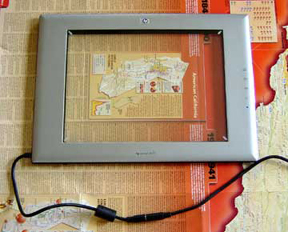Product review
Lincoln Cushing, Bancroft Library, UC Berkeley
this review appears in the
Fall 2004 Progressive
Librarian Journal
HP Scanjet 4670

Working in a small academic research library, I routinely came across situations where available and affordable image capture technologies did not exist. If a graduate student looking through our oversize bound volumes of 1930s labor newspapers found just the right article he wanted, all he could do was to take notes. If an independent scholar wanted an image of a portion of a local history map, a fuzzy camera snapshot might be her only option. Many relevant documents in collections are too fragile or too large to be flopped onto a standard flatbed scanner or copier. Existing scanners are designed to work facing up, and most affordable digital cameras offer resolution too low to adequately capture text. Conveniently, a new consumer electronics product appeared recently that offers tremendous opportunities for information management professionals – the HP Scanjet 4670, available for less than $200.
This scanner is very slender (less than an inch thick without its desktop base) and uses a USB 2.0 high-speed connector. A separate power supply must also be connected to the scanner head. Included software is compatible with both Macs and PCs, and it has an optical resolution of 2,400 – by –2,400 dpi. It has not received very good reviews when compared to other flatbeds (the October 2004 MacAddict ranked it fifth out of five for bargain scanners), and has received bad marks about scan quality, color fidelity, and pixel noise. These are all true, but this device can do things no other device on the market can. Its best and most unique feature is that scanning takes place on top of a document. It looks like a small picture frame with an 8 1/2 x 11” capture field, and the scanner head runs between two clear panels. You look through the device, position the frame exactly where you want on top of the document, and hit the scan button at the edge of the frame. For larger originals, you can make multiple adjacent scans that can be later stitched into a larger whole with the included “Panorama Maker” software. For smaller areas, “Preview Scan” lets you select a portion of the frame to capture.
Like many scanners these days, it comes with Optical Character Recognition (OCR) software that makes it easy to convert scanned documents to machine-readable text. Operation is pretty straightforward – after scanning an item in “Scan Document” mode it automatically opens Readiris Pro 7, translates the scan, and opens it as a word processing document in the application of your choice. As with any OCR software, the better the input quality the better the results. Some text may require reformatting after converting, but that can be done manually by comparing text against the image scan. Another useful feature is “Make Copies,” which bypasses many of the usual scanning steps and simply pops your scan out on your local printer. It’s just like having a photocopier on your desk. The scanner also includes a 35mm slide/transparency attachment. Although this produces lower quality scans than one would get from a dedicated slide scanner, it offers an adequate method for capturing satisfactory images from these formats.
This scanner should definitely be considered a unique and useful image capture tool for libraries and archives. Documents that were previously off limits to patrons for duplication can now be safely copied with minimal harm, and text can be generated in machine-readable format.
Notes:
Is scanning safe for fragile documents? For all
practical purposes, yes. See excellent article
from RLG DigiNews, "Light Levels Used in Modern Flatbed
Scanners" by Timothy Vitale.
Also, unlike cameras, scanners cannot capture detail that is not right up against their surface (the ability to focus at a range of distances is known as depth of field in photography). Therefore, these devices will not do a good job where the area to be scanned drops off, such as in the gutter of a book.
return to Docs Populi/Lincoln Cushing library culture page